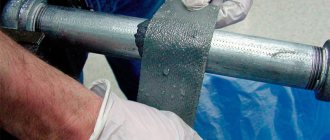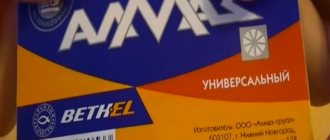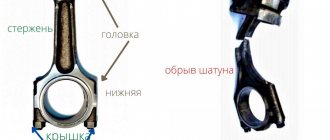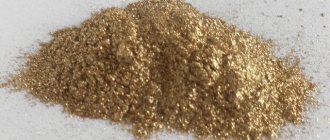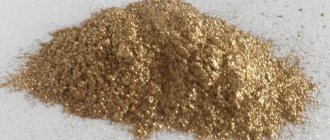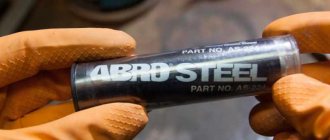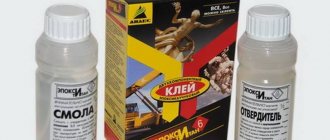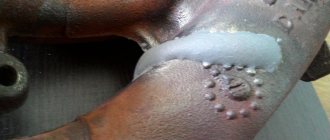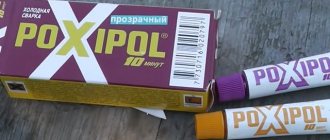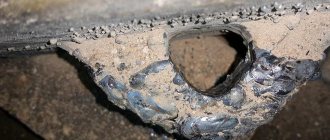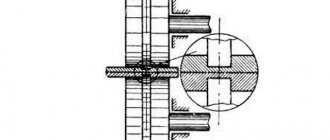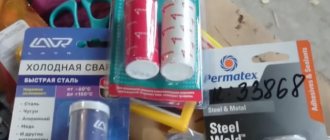Mastix cold welding can be used to join various parts and structural elements without melting. The joining process will be represented in the form of gluing. New interatomic bonds are not formed, plastic deformation does not occur, which happens during traditional welding, so we need to talk about glue, and not welding in its usual sense.
Technical characteristics of the glue
Mastix cold welding composition is multi-component. It includes the following components:
- Epoxy polymer (adhesive base).
- Plasticizers (used to increase the resistance of the epoxy polymer to mechanical loads, shocks, and vibrations).
- Fillers (mineral, metal). Thanks to them, the thermal conductivity of the glue increases and the strength characteristics are improved, which makes the connection resistant to temperature changes.
- Polyamine or amine hardener (necessary to stimulate the hardening of the mixture - hardening of a thin layer of Mastix cold weld occurs within a few minutes).
The percentage of components will depend on the type of Mastix cold weld. The manufacturer offers a wide selection of products designed to solve various technical problems.
The adhesive mass is presented in the form of a material resembling plasticine. It has a rod shape and consists of 2 layers separated by packaging (mix the layers before use). Products are produced in soft packaging. It is recommended to store at a temperature of no more than +30o C. Important characteristics include:
- Minimum operating temperature: -60° C.
- Maximum operating temperature: +200° C (or more depending on the type of glue).
- Beginning of the hardening process: 7 minutes after application.
- Weight: 55 g.
- Recommended storage temperature: no more than +30° C.
Popular formulations
Among the wide variety of modifications, the most popular is the “Blitz Batyr” series of universal products. The adhesive is intended for joining any materials, including ferrous and non-ferrous metals, plastics, ceramics, wood and glass. With its help, you can restore a failed part or eliminate a leak in a container. The adhesive is very easy to apply and does not require careful preparation of working surfaces (installation can be carried out on damp, dirty and oily substrates).
Welding "Blitz Batyr" consists of epoxy-dian resin , plasticizer, amine hardener, kaolin, chalk, silicon dioxide and iron oxide pigments. Welding production is regulated by technical specifications 2252 023 90192380 2011 and meets all standards.
No less popular is “Batyr” with steel filling. The composition of the adhesive is represented by epoxy-diane resins, amine hardener, plasticizer, hardening accelerator, kaolin, chalk, silicon dioxide and steel powder. The composition can be used at a temperature of 0 degrees.
Product area of use
The scope of application of Mastix cold welding will directly depend on the type of adhesive chosen. Therefore, the products are ideal for use in the following areas:
- Bonding of metal products, structural elements, parts.
- Durable connection of metal and non-metal products.
- Bonding of metals that during operation heat up to extreme temperatures (more than 200° C).
- Repair of plumbing products, gluing tiles, porcelain, marble, etc.
- Bonding of steel products.
- Bonding of aluminum products.
Where is it used?
Mastix cold welding can be used both at home and in professional work. It all depends on the type of material and environmental conditions. The main type of its application is the use of cold welding in the form of ordinary glue. It must combine those materials that cannot be glued together with ordinary glue.
Very often it is used to repair pipes in water supply systems, seal holes in containers, repair machine parts, and much more. The plastic mass, which is this mixture, perfectly seals cracks (it can even penetrate inside the object). If the item is not used at temperatures above 150 degrees, then cold welding can effectively repair all chips in it; with its help, you can complete necessary or missing parts or repair equipment in another way. It is very important not to use the part until the glue has dried.
The material that is obtained after cold welding has dried is not strong enough to withstand the loads of strong impacts. But it can easily withstand the loads caused by vibration, which is why it is very effectively used for repairing moving mechanisms. Mastix cold welding contains the following components:
- Fillers of mineral origin;
- Metal fillers;
- Epoxy resin;
- Amine resin.
Advantages and disadvantages
Mastix cold welding is one of the most popular in its category on the Russian market.
This is due to the presence of the following positive characteristics:
- Versatility of use with metal and non-metal parts and elements.
- High-quality gluing of parts (better than many other types of similar adhesives).
- The ability to purchase a specific type of Mastix cold welding to perform a specific job (for example, joining plastic and metal products, repairing automotive parts, plumbing equipment, etc.).
- Easy to use and prepare - no special skills or experience are required to work with the mixture.
- Low cost (when compared with foreign analogues and products of other well-known domestic companies).
- Sophisticated delivery (sold as a two-component rod).
- Possibility of operating the finished connection at extreme sub-zero and plus temperatures.
The disadvantage of cold welding Mastix is that the drying time of the mixture is about 6-7 minutes. This is more than competing products. When carrying out urgent work, such time costs can be critical. Although this is still controversial and subjective.
Also, when mixing two components, you need to be extremely careful so that lumps do not form. They form frequently, so this fact can also be considered a disadvantage.
Types of cold welding Mastix
The Russian manufacturer Mastix offers different types of cold welding, which are produced under the brand of the same name:
- "Gas Tank Sealant" It is used for repairing gas tanks of trucks, agricultural machines, and special equipment. Tanks can be plastic or metal. Work can be carried out on oiled and water-filled surfaces.
- "Radiator sealant." A complete analogue of the previous mixture, but is used only for repairing radiators.
- "Glue for aluminum." Officially, it should only be used for bonding aluminum parts and structural elements. In practice, it is actively and successfully used for joining wooden, plastic, ceramic, and metal products in various combinations.
- "Glue for batteries and pipes." The mixture can be used to work with cold and hot pipelines, sewer systems, and batteries. Suitable for use in industrial and domestic areas.
- "Glue for bronze." Used to connect bronze products, as well as parts made of other types of non-ferrous and ferrous metals.
- "Glue on oily surfaces." If it is impossible to clean the surfaces to be joined from traces of oil, it is recommended to use this cold welding Mastix. When working with oiled surfaces, it makes a connection 50-70% better than traditional adhesives.
- "Glue for metal." Contains metal filler. Used for all types of metals. Has a wide operating temperature range.
- "Glue for plumbing." A specialized adhesive mixture designed for use in the repair of plumbing equipment, as well as decorative products and finishing materials made of ceramics, porcelain, plastic, and wood.
- "Fast Steel" This type of Mastix cold welding ensures the fastest possible gluing of parts.
- "Heat-resistant glue." It is a traditional adhesive mixture, but it contains special components that allow its permissible operating temperature to be increased to 250° C.
- "Universal glue." An excellent option for household use, for joining parts and surfaces made of various materials.
- "BLITZ universal glue." Similar to the previous composition, but has a higher hardening speed.
Self-repair technologies
Method 1. Iron-rosin flux
So, how to solder a damaged aluminum radiator? The easiest way is to use rosin-based flux. The instructions will be as follows:
- Preparation. We clean the area to be treated, removing any remaining paint and dirt, then sand the metal with an abrasive and degrease it with a solvent. The more carefully we carry out all this work, the more effective the repair will be.
- Preparation of flux. We melt rosin in a metal crucible, gradually heating the container and stirring the melting substance. Add iron filings in small portions (1 part to 2 parts rosin) and stir until the mixture is completely homogeneous.
- Surface treatment. We cover the area to be repaired with a thin layer of molten iron-rosin flux. The fewer missed sections, the higher the quality of the repair.
- Soldering. We collect a small amount of solder on the soldering iron, and then apply it in a circular motion to the aluminum under a layer of flux. Iron filings act as an abrasive: they clean off oxides, ensuring a bond between solder and aluminum. Melted rosin allows you to minimize the access of oxygen, so secondary oxidation does not occur.
The main disadvantage of this method of soldering aluminum is its complexity. It is almost impossible to treat such large damage, since the flux hardens quickly and the quality of the repair is reduced.
Method 2. Homemade flux
When repairing fairly large damage to aluminum radiators with your own hands, you can use special compounds - flux. In this case, the work is performed like this:
- Preparation. We prepare the defect site according to the scheme described in the previous section, cleaning and degreasing the metal.
- Fluid components. Sodium sulfate (4%), potassium chloride (56%), lithium chloride (23%), cryolite (10%) and table salt (75%) are individually ground in a mortar almost into powder. After this, pour the materials into the crucible and mix until a homogeneous powder is obtained.
- Preparing the floodplain. Pour the dry ingredients into the crucible and melt until smooth, stirring gently.
- Soldering. We apply a thin layer of flux to the surface, which is preheated using a gas burner. After this, we solder the damaged area using tin-lead solder with the addition of bismuth.
Method 3. Low-temperature solder with sizing
A car radiator differs from heating radiators primarily in the configuration of the tanks. When troubleshooting a problem, you have to solder small thin-walled tubes and plates, so the methods described above will not always be applicable.
An alternative is to use aluminum solder rods with a low melting point. An example of repairing a radiator is given in the table:
| Illustration | Work stage |
| Cleaning up the area. |
Using sandpaper or a special attachment on a drill/screwdriver, we clean the aluminum, removing the film of oxides.
We treat the area with a solvent, removing organic contaminants and oxide residues.
Using small pliers, we crimp the damaged area, reducing the area of the hole. This is done to facilitate the soldering process.
Using a gas burner, we warm up the area. After this, we introduce a rod of solder with a low melting point into the flame and rub it over the damage.
With each pass, solder particles will be deposited into the hole and onto the surfaces around it, gradually eliminating the defect.
After soldering is complete, apply high-temperature aluminum adhesive over the repaired area.
When polymerized, this material will close all micropores, which will significantly increase the reliability of the repair.
https://youtube.com/watch?v=oMgfIKd1unY
Instructions for use
Before starting work, you must study the instructions for use from the manufacturer of cold welding Mastix. Work must be carried out in the following sequence:
- First, the working surfaces are prepared: cleaning from scale, traces of rust and other contaminants. Surfaces need to be wiped, dried, degreased (if possible).
- At the second stage, you need to separate a third of the rod and mix the components with rubber gloves soaked in water. Proper mixing will be indicated by the shade of the mixture: uniform, without lumps, noticeable inclusions, or streaks.
- At the third stage, the resulting mixture must be applied to the two surfaces to be joined, connected to each other, and secured.
- The duration of fixing parts is 15-18 minutes.
If the surfaces are dirty, oiled, or moistened, then the strength characteristics of the resulting joint are reduced by approximately 20-30%. This is when compared with prepared and clean surfaces.
If work is carried out in conditions of negative temperatures, then during the preparation process, warm the mixture in your hands for several minutes. Be sure to store in a warm room before using in the cold.
By the way, according to my observations, all tubes contain generalized instructions. Which contains recommendations separately for all types of Mastix brand glue.
Mastix cold welding reviews
- Andrey, 35 years old: “My child constantly breaks and spoils something, so I often have to glue everything together. I always used regular superglue, but then I encountered a broken metal dresser handle. The handle was heavy, so you couldn’t put it on with superglue. I bought Mastix “Universal” cold welding at a hardware store. Mixed according to the instructions and applied to the surface. As a result, the pen has held up for several years.
- Mikhail, 44 years old: “For the first time I had to use Mastix cold welding at the dacha - there was a hole in an aluminum bucket that I didn’t want to throw away. As a result, I mixed two substances according to the instructions, and it turned out to be a mass in the form of plasticine. I filled the hole with her. As a result, the mass froze and turned out to be something like metal. The bucket no longer leaked. Now I’m thinking of sealing the holes in the water barrels with this cold welding.”
- On behalf of myself as the author of the site, I will add that I have successfully used this welding several times. Using “universal” I tightly glued the decorative part of the handle to the chest of drawers in the bedroom. The handle is always under load, watch my video here. Other options were not suitable for gluing either plastic or laminate. Heat-resistant welded a serious crack in the battery because he overdid the tightening at the junction of the pipe and the section. There is no heating pressure, the cottage is private. Therefore, I don’t know if it’s suitable for a centralized system. I think it won't be a problem for a small leak. I also like the affordable price of the glue, another plus is the large selection of ranges of use.
